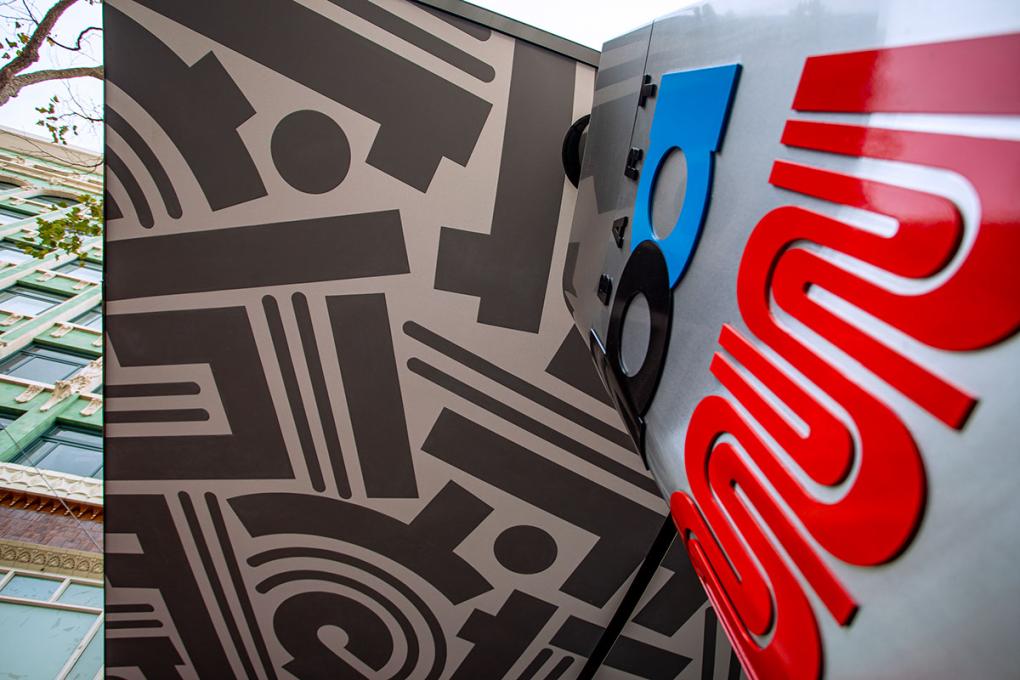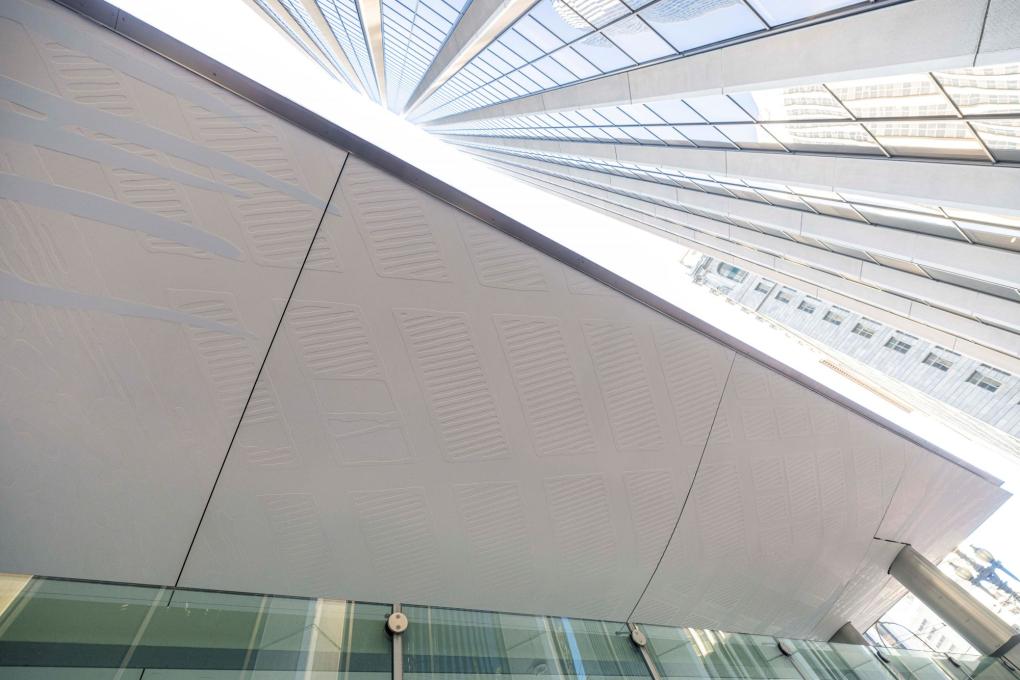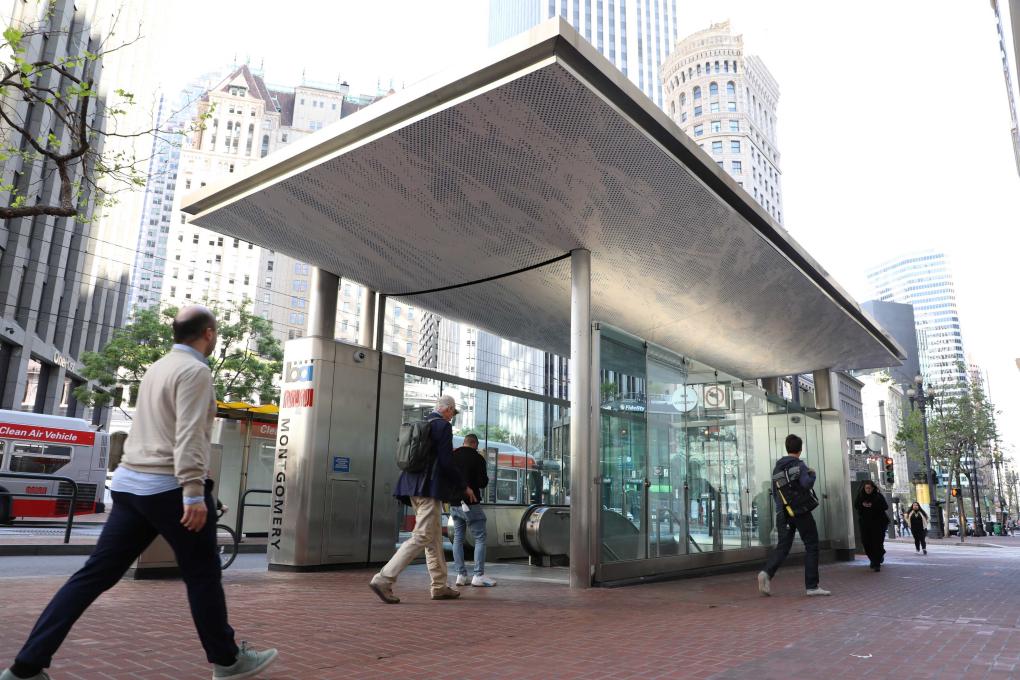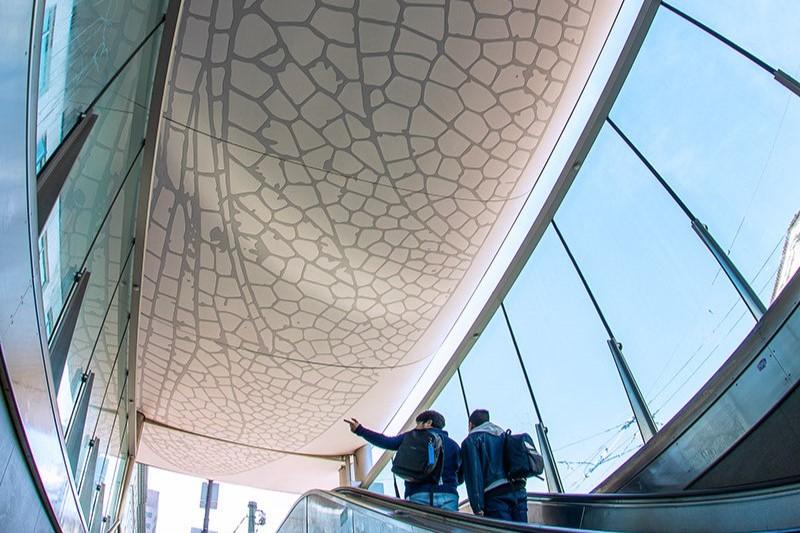Meet the artists who created original works for BART’s Downtown San Francisco escalator canopies

“Your Turn" by Aaron De La Cruz, Powell St. Station
Recently constructed canopies along San Francisco’s Market Street are protecting station escalators and helping to beautify the busy downtown corridor with four site-specific artworks that reflect the neighborhoods around them.
The canopies are being constructed as part of the San Francisco Station Canopy Project, happening in tandem with BART’s San Francisco Station Escalator Replacement project, which is installing and replacing escalators at Embarcadero, Montgomery St., Powell St., and Civic Center stations.
The new canopies aren't just coverings for the escalators. Each structure is equipped with LED lighting, multiple security cameras, digital screens that display real-time transit information, and motorized gates that allow the entrances to be locked at street level when stations are closed. In addition to protecting the new escalators from wear and tear, the canopies provide an extra layer of station security and cleanliness, all while brightening Market Street with placemaking artwork that subtly reveals itself as you travel between station and street.
Incorporating art was an important piece of the canopy project, as was ensuring the imagery resonated with the people who live along the corridor.
“It was crucial to not view Market Street as a monolith during this process,” said BART Art Program Manager Jennifer Easton. “The street has different communities and parts to it, and that was a key aspect to convey with this project."
Four artists were selected to create the art after a national call hosted by the Art Program: Norie Sato (Embarcadero Station), Rosana Castrillo Díaz (Montgomery St. Station), Aaron De La Cruz (Powell St. Station), and Ron M. Saunders (Civic Center Station). Easton assembled jurors from different sections of Market Street to make sure the neighborhoods were represented authentically.
The process of translating the artworks onto the surface of the fiberglass-reinforced plastic canopies is a saga unto itself. BART worked with VIA – A Perkins Eastman Studio to develop a method that would maintain the integrity of the artists’ original designs while ensuring the works would last for decades in their outdoor environments.
“There was a lot of study and analysis to get this right. I don’t believe anyone has done something quite like this for a transit project,” said architect Steve Line of VIA.
VIA’s final designs utilized fiberglass-reinforced plastic that is extremely durable but also pliable enough to achieve the gentle curved shape of the canopy undersides.
“First, we used software to analyze the 2D images of the art and surface map them. Then we created a 3D file that recreated the different tonal qualities of the pieces,” Line explained.
Next came the process of bringing the 3D files into the physical world. Technicians began by spraying clay on a large metal pool the same shape as the canopies then using computer coding to instruct a house-sized milling machine to etch the art onto the surface. This clay relief was layered with strong carbon fibers, similar to those used in rocket ships, and vacuum sealed. Once cured, technicians grinded or sandblasted the surfaces to smooth perfection.
Let’s hear from the artists.
Embarcadero Station – “We Touch Here,” Norie Sato

Artist Norie Sato wants her canopy artwork to inspire “people to pay attention to the balance between humans, the land, and the water.”
Her artwork features a fingerprint pressed between flowing water and an aerial view of the Embarcadero neighborhood.
“I was really interested in the effect of human building and intervention on the land, and also in how the human plays the intermediary between the built environment, which the map symbolizes, and the water, which encircles the land in many ways,” Sato said, speaking from her Seattle studio.
For Sato, transit plays a crucial role in the fine balance between humanity and the natural world.
“[Transit is] very accessible; it’s available to anyone, and it’s also ecologically conscious because it carries many people at one time,” she said.
Sato spoke of the “democratization that occurs” when riding public transportation: “We all ride the same train, and it doesn’t matter who we are or how much money we have, yet we all get to the same place.”
Montgomery St. Station – “Untitled,” Rosana Castrillo Díaz

San Francisco-based artist Rosana Castrillo Díaz’s first thought when assigned Montgomery St. Station was, “How fun!”
Díaz said she heavily researched the station and its surroundings before creating her design, which features a flowing stream of water. What stood out most deeply to her about Montgomery St. Station, she said, is its bubbling, effusive energy.
“My imagination immediately went to water, and water as this fluid element that we all possess that has so much energy,” she said.
Díaz said she hopes her piece projects the station’s vigor and lifelines, but also a sense of calm.
“I think of all these people coming in and out of the station as drops of water,” she said. “Like water, they are fluid, vital, essential.”
Powell St. Station – “Your Turn,” Aaron De La Cruz

Aaron De La Cruz, a San Francisco artist, was “in shock” when he learned he was one of the four artists selected to create a canopy piece.
“I couldn’t believe it,” he said. “It feels like I won a gold medal in the Olympics.”
De La Cruz, like Díaz, was inspired by his station’s energetic spark.
“I went with lots of signature curl movements in my piece that, for me, kind of represent the trolley coming down and spinning in front of the station,” he said.
He also wanted to create a piece that was characteristically “funky.”
“I really wanted to do something to address that there’s some of us in the Bay who are here and not interested in changing things,” he said. “I want to tell those stories and really preserve the funk of San Francisco.”
“For example, the bold lines in the artwork represent the people, sounds, and places from the past that established so much of what San Francisco is today,” he continued. “That culture is so prevalent that it ripples outward through new generations represented by the thin outer lines on the forms. The preservation of the past while building the future is why I titled the piece ‘Your Turn.’”
Civic Center Station – “Dragonfly Wing,” Ron M. Saunders

When it comes to public art projects, artist Ron M. Saunders knows, “You just have to go with it.”
The fine art photographer said he and his fellow artists are interested “in this kind of work because it gives something to the public and brings a little bit of beauty into harsh environments.”
Saunders’ piece is a closeup of a dragonfly wing. Dragonflies, he said, speak to “transformation, adaptability, and growth,” much like the ever-changing neighborhood where Civic Center Station is located.
“The Tenderloin was founded during the Gold Rush,” he said. “It’s always changing, just like a dragonfly can change directions quickly.”
Saunders said he’s never created an art piece “this big,” but he relished the challenge.
“It’s just exciting to work on a project of this scale,” he said. “There’s a power in having art in stations. It forces people to slow down.”
The San Francisco Station Canopy Project, which was funded by voter-approved Measure RR, San Francisco Prop A, and state Prop 1A, is happening in parallel with the San Francisco Station Escalator Replacement Project. To learn more about the canopy and escalators project and view timelines, click here and here.
To learn more about the BART Art Program, click here.